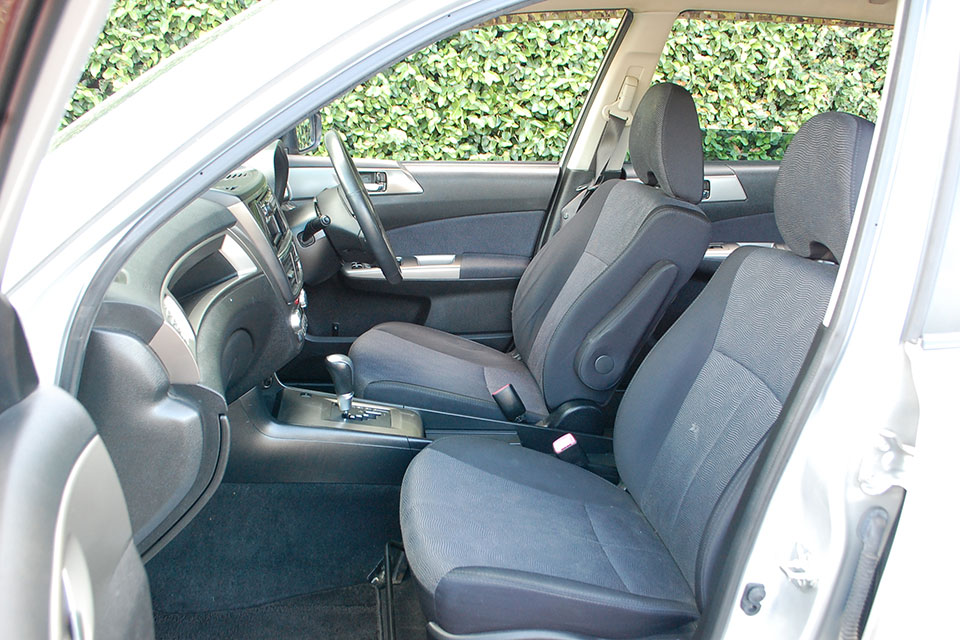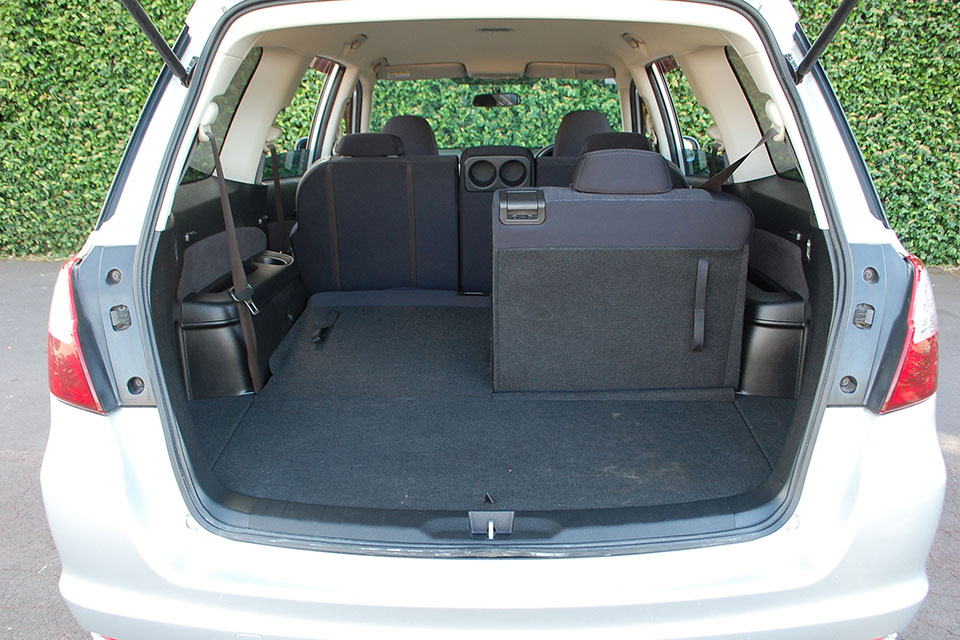Subaru Exiga 2008-2014 used car review
The Subaru Exiga is more car-like than other seven-seat vehicles.

The Subaru Exiga is more car-like than other seven-seat vehicles. Choose the more powerful versions if you can as the base model lacks power.
The Subaru Exiga is a seven-seat people mover, closely related to the Subaru Legacy and Subaru Impreza. Unlike most people carriers it looks more like a station wagon than a small van. There are standard and high-performance versions, and the range includes a rare STi sports model. The Exiga was replaced by an updated Exiga Crossover7, which is an off-road version similar to the Subaru Outback.
Inside and out
The Exiga shares some of its looks with the fifth-generation Subaru Legacy wagon, though it is slightly shorter and narrower. It has a taller roof and is longer between the wheels, which creates additional interior space. The nose is raked and sharp, with projector-style headlamps and a large chrome grille.
The tall roof looks slightly like it floats due to tinted windows and blacked-out side pillars. The rear doors are like a traditional car's, not the sliding type normally found on this kind of vehicle. There are twin-exhaust tips under the rear bumper.
The cockpit of the Exiga is simpler in design and materials than a Legacy and looks more like an Impreza. The interior plastics feel a little hard and cheap. The steering wheel adjusts for tilt and reach, and you get a good view of the simple gauges with a centre speedometer.
The stereo in the review car is an aftermarket CD player. The air-conditioning is a climate control system - though it is a disappointment for a three-row vehicle that only the front row gets air vents. A handy storage pocket sits above the glovebox.
The driver's seat is adjustable manually for height but the front passengers are not. They are of a medium softness and offer good side support. Both front row occupants get fold down armrests. The second row offers good legroom and excellent legroom.
The centre seatback folds forward to provide an armrest, although this may make the seat a little uncomfortable for the middle passenger. The left-hand side of the seat folds and tumbles forward to allow access to the two third-row seats.
This is one of the better third rows we have tried in a car of this size - adults up to 180cm will be comfortable for reasonable distances. They even get an armrest moulded into the side of the car.
With all seats in use there is not much of a boot available, at 195 litres space is around the same as a very small hatchback. Fold the third row forward - it splits in half - and 460 litres is available or enough for four to five large cases. The boot floor is a little high which can make it tricky to lift in heavy items, though the counter to this is storage space underneath.
On the road
Three engines are available in the Exiga - a 2-litre four-cylinder in standard and turbocharged forms. A 2.5-litre four-cylinder engine is also available though is a little trickier to find. Initially the Exiga was available in front or all-wheel drive with a four-speed automatic or CVT automatic as the standard transmission.
The front-wheel drive option was dropped in 2012. The turbocharged model uses a five-speed automatic with manual shifting and has all-wheel drive as standard. While front-wheel drive models may be more fuel-efficient they don't offer the grip and handling bonus Subaru's system provides.
The review car's 2-litre engine produces 109kW and 191Nm, which is not a lot of power for a car of this size. The CVT automatic makes things worse as it can make the engine run at higher resolutions and sound like it has to work very hard. You can select your gear ratios which helps a little.
Our pick of the available engines would be the 2.5-litre version, however, it is a little harder to find. Conversely, handling is very good with little body roll and responsive steering. The ride is also excellent.
While forward and side visibility in the Exiga is reasonably good, the three rows of headrests do restrict vision to the rear slightly. Reversing cameras are not standard on the lower-level models like this, though are very commonly fitted. This is an option to look for when you shop.
We could not find a tow rating for the 2-litre model, though it should be similar to the 2.5-litre version sold in Australia. It can pull up to 750kg unbraked (a medium-to-large garden trailer) and 1400kg braked (a small trailer boat).
Safety
The Exiga (2009-2014) carries a five-star Used Car Safety Rating. The safety of individual cars varies significantly, however, with side and curtain airbags only an option on most models. Look for SRS logos on side pillars and the front seat side and prioritise these cars as they offer more protection. Electronic Stability Control is fitted to most Exigas, while Electronic Brakeforce Distribution is standard.
There are ISOFIX child seat mounts in the window positions in the rear seat and seat tether points on the base. The centre second-row passenger only gets a lap belt until a 2012 model update.
Some models from 2009 have the option of “Eyesight”, Subaru's camera-based safety assistant which includes Autonomous Emergency Braking, Adaptive Cruise Control and Lane-keeping Assist. It is obvious if a car has this feature because a camera is visible either side of the rear-vision mirror when looking through the windscreen.
Reliability
The engines and transmissions in this generation Exiga have developed a reasonable record of reliability in other models. If there is a downside, the 2-litre engine requires regular cambelt replacement which costs from $1250 each time.
A rare failure of the main airbag module (not related to the well-known Takata airbag recall) can be spotted via the SRS warning light on the dashboard. It needs a specialised technician to fix it with the correct Subaru scanning tool, which costs up to $1000.
Check under the car for signs of corrosion since Subarus are popular for visiting skifields and snowy areas both here and in Japan (where our used import review vehicle came from).
Subaru’s corrosion protection is usually very good but look for discolouring and bubbling of metal surfaces around the suspension and rear differential. Avoid the vehicle if you see that.
Cost of ownership
Our local Subaru dealer suggested the Exiga be serviced every six months at a cost of $250 to $275. The 2-litre version will need its cambelts replaced every 100,000km at a cost from $1250.
RightCar estimates that over 14,000km of driving a year, an Exiga with a 2-litre engine and CVT automatic will cost $2070 a year to fuel. This is low for a car of this size and is largely down to the CVT automatic. At $2 a litre the 70-litre tank costs $130 to fill and will take you up to 810km before the fuel light comes on.
A vehicle licence for a 2009 Exiga costs $76.92 a year, with the car in the cheapest ACC levy group. The cost will rise next year when the risk rating system is scrapped.
Trade Me Insurance estimates insurance for a car worth $9920 will cost $60.06 per month. That is very high for a car of this type and value.
Buyers’ guide
The Subaru Exiga is available on Trade Me priced from $5500 to $16,500. Late model 2.5-litre and 2.0GT models will gain the most money, while the cheaper cars are 2-litre versions.
A very small number of Liberty Exiga models have made their way into the country from Australia. Be wary of these as they are likely to be vehicles that were damaged in Australia and repaired.
Variants
- 2.0I - Powered by a 2-litre four-cylinder engine with a CVT automatic or four-speed automatic. Features steel wheels, fog lights, manual air-conditioning and a leather steering wheel.
- 2.0I-S - Adds alloy wheels, climate control air-conditioning and contrasting seat fabric.
- 2.5I - Powered by a 2.5-litre four-cylinder engine with a CVT automatic. Spec as per 2.0I-S with part-leather upholstery.
- 2.5I-S - Adds cruise control, SI drive control system, smart key system and separate temperature settings for the driver and passenger.
- 2.0GT - Powered by a 2-litre turbocharged engine with a five-speed automatic. Adds sports suspension, wing mirror indicators, HID headlights, electric driver seat adjustment and sunroof.
A range of special packages, such as leather, Eyesight and an STI tuning package is available.
Timeline
- 2008 - Launched in Japan
- 2009 - 2.5-litre engine option added
- 2012 - Given slight update
- 2015 - Replaced by Exiga Crossover7
Details
2009 Subaru Exiga 2.0I-S
$6,300 to $17,000 for models which have travelled 70,000 to 120,000km
2.0-litre four-cylinder, 109kW/191Nm (claimed)
CVT automatic, all-wheel drive
Five-star Used Car Safety Rating
10,000km or six months
Space saver
7.4-litres per 100km (claimed)
Regular
4740mm
1775mm
1660mm
11m
(2.5-litre model) 750kg (unbraked), 1400kg (braked)
This review covers the Subaru Exiga for model years 2008, 2009, 2010, 2011, 2012, 2013 and 2014.
Review vehicle supplied by Turners Cars.
*Our insurance estimates are based on a 35-year-old male with no accidents in the last two years, garaging the car in Mission Bay, Auckland. The car is not used for business and will cover 10,000km to 20,000km a year. We estimate with no option add-ons and $500 excess. Customise your estimate at Trade Me Insurance.
Image gallery
Also consider







